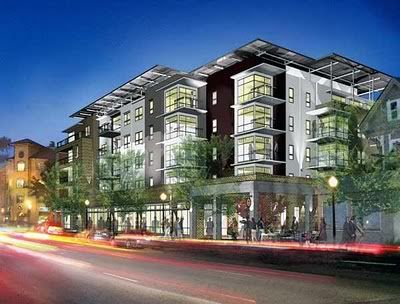West Sacramento is working on ramping up the Bridge District marketing campaign as the project slowly works towards actual project construction (buildings). To help build excitement, they recently sent out a fun little marketing piece meant to remind those interested in the project about what this project will mean for not only West Sacramento, but the Northern California Valley region in general.
Here's the poster they sent out:
You are part of something big.
History suggests that every 50 years or so, Californians suddenly wake up and remember: "Hey, we live in California!"
The last time this happened we called it "mid-century modern." It celebrated something unique to California living: that we can be outside almost every day of the year enjoying our mild climate and the amazingly diverse landscape it produces. Entire wall in houses suddenly became glass, and we marveled at how architecture could blur the line between inside and outside. These "moderns' carved new spaces for healthy outdoor living out of conditions that had always existed- but had not been fully exploited since the turn of the century days of sleeping porches and verandas. They took an idea that was at the core of who we are as Californians and updated it-making it relevant to its time.
As revelatory as this might have been, however, the buildings we've seen built in recent years seem to have forgotten again what is special about our place in the California sun. but, healthy out-door living is no less important to us today than it was fifty years ago. In fact, it may be more important than ever. So, shouldn't today's buildings and neighborhoods honor our connection to the outdoors and re-imagine it in a 21st century way? We say yes. After all, if who we are is at least partially defined by what we build, then what we build should make every effort to strike a meaningful relationship to the beauty of what is all around us.
Another way we are looking back as a way to see forward is apparent in today's growing interest in neighborhoods that recover what is great about the way our parents and grandparents used to live - before they moved to the suburbs. People are searching again for those rich, connected, everyday experiences that a walkable neighborhood provides. And we agree, it's time for a re-think of neighborhood density, and how shops, restaurants, and services are integrated into everyday life to best suit today's needs while restoring a bit of loveliness to life in the process. In this century, it's inevitable that our cities will change-so let's make it for the better
Now, you might think that these notions of healthy outdoor living and a connected, walkable neighborhood are mutually exclusive idea-but they aren't. They just haven't been put in the same mixing bowl for a while. We can change that. For, in addition to our great weather, the beauty of our food, and our independent spirit, there is something else that binds us together as Californians: our belief in the power of deign to improve people's lives.
So, it is for you, one of the first in a generation to remember: "Hey, we live in California!" that we've made the enclosed map. We wanted to get it to you as soon as possible to reassure you that California's next great 21st century neighborhood is well on its way to being realized. It's called The Bridge District, and we thank you for being part of it.
Development and city growth are inevitable and coming up with a fresh vision of how to house new growth is a worthy goal - one that The Bridge District (TBD) is clearly attempting. I worry that the idea of bringing people together in an old fashioned, dense, town style environment is great on paper, but will end up proving more difficult in real life. My wife and I are increasingly enjoying spending our entertainment dollars in Downtown Sac at the ever increasing number of restaurants and bars in that area, we've even wondered if moving downtown could be an option. What keeps us in the suburbs is the idea that we plan to have kids soon, and the suburbs just seem like the right place to raise a kid.
What I can say though, is that many of the modern subdivisions have been built with strict separation of zoning codes. This creates huge islands of housing where any resident will likely have to drive a few miles just to get to the closest shops. I think the core of this new thinking emulated by the TBD design plan is a recognition that people want "things" to be close - where uses are not necessarily separated by miles of feeder roads and uses are mixed in such a way that there are a few shops or restaurants within walking or a short bike ride.
I struggle with the idea though, that dense community designs, are exclusively the appropriate direction to head in community planning. I think given the option, most people would like to have their own backyard and their own personal garage to store off season items and keepsakes - parking garages and highrise living is fun to think about, but if there are inexpensive single family options nearby, my guess is that most will choose their own home over a condo. Don't get me wrong, I am more than excited about the TBD plan and can't wait to visit the first restaurants and shops, but I just hope that the vision is properly aligned with demand so that the development will reach its full growth potential.
More to come later. . .
http://www.thebridgedistrict.com/
http://www.fulcrumproperty.com/prop.aspx?id=13&prop=14&par=2
































